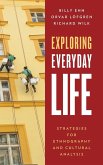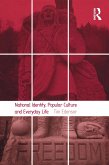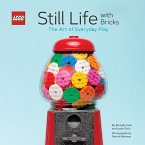Billy Ehn, Orvar Löfgren, Richard Wilk
Exploring Everyday Life
Strategies for Ethnography and Cultural Analysis
Billy Ehn, Orvar Löfgren, Richard Wilk
Exploring Everyday Life
Strategies for Ethnography and Cultural Analysis
- Broschiertes Buch
- Merkliste
- Auf die Merkliste
- Bewerten Bewerten
- Teilen
- Produkt teilen
- Produkterinnerung
- Produkterinnerung
Explores and explains how the mysteries of everyday life-from conversations and observations through web browsing and popular culture-can become the basis of rich ethnography and deep cultural analysis.
Andere Kunden interessierten sich auch für
![Exploring Everyday Life Exploring Everyday Life]() Billy EhnExploring Everyday Life111,99 €
Billy EhnExploring Everyday Life111,99 €![National Identity, Popular Culture and Everyday Life National Identity, Popular Culture and Everyday Life]() Tim EdensorNational Identity, Popular Culture and Everyday Life48,99 €
Tim EdensorNational Identity, Popular Culture and Everyday Life48,99 €![Ageing selves and everyday life in the north of England Ageing selves and everyday life in the north of England]() Cathrine DegnenAgeing selves and everyday life in the north of England119,99 €
Cathrine DegnenAgeing selves and everyday life in the north of England119,99 €![Everyday Post-Socialism Everyday Post-Socialism]() Jeremy MorrisEveryday Post-Socialism97,99 €
Jeremy MorrisEveryday Post-Socialism97,99 €![Everyday Life in Asia Everyday Life in Asia]() Devorah Kalekin-FishmanEveryday Life in Asia200,99 €
Devorah Kalekin-FishmanEveryday Life in Asia200,99 €![Caste in Everyday Life Caste in Everyday Life]() Caste in Everyday Life97,99 €
Caste in Everyday Life97,99 €![LEGO® Still Life with Bricks: The Art of Everyday Play LEGO® Still Life with Bricks: The Art of Everyday Play]() LEGO® Still Life with Bricks: The Art of Everyday Play11,99 €
LEGO® Still Life with Bricks: The Art of Everyday Play11,99 €-
-
-
Explores and explains how the mysteries of everyday life-from conversations and observations through web browsing and popular culture-can become the basis of rich ethnography and deep cultural analysis.
Hinweis: Dieser Artikel kann nur an eine deutsche Lieferadresse ausgeliefert werden.
Hinweis: Dieser Artikel kann nur an eine deutsche Lieferadresse ausgeliefert werden.
Produktdetails
- Produktdetails
- Verlag: Rowman & Littlefield Publishers
- Seitenzahl: 162
- Erscheinungstermin: 23. Juli 2015
- Englisch
- Abmessung: 229mm x 152mm x 9mm
- Gewicht: 245g
- ISBN-13: 9780759124066
- ISBN-10: 075912406X
- Artikelnr.: 42548536
- Herstellerkennzeichnung
- Libri GmbH
- Europaallee 1
- 36244 Bad Hersfeld
- gpsr@libri.de
- Verlag: Rowman & Littlefield Publishers
- Seitenzahl: 162
- Erscheinungstermin: 23. Juli 2015
- Englisch
- Abmessung: 229mm x 152mm x 9mm
- Gewicht: 245g
- ISBN-13: 9780759124066
- ISBN-10: 075912406X
- Artikelnr.: 42548536
- Herstellerkennzeichnung
- Libri GmbH
- Europaallee 1
- 36244 Bad Hersfeld
- gpsr@libri.de
Billy Ehn is professor emeritus of ethnology at Umeå University in Sweden. He is co-author, with Orvar Löfgren, of The Secret World of Doing Nothing. Orvar Löfgren is professor emeritus of ethnology at Lund University in Sweden. His publications include On Holiday: A History of Vacationing. Richard Wilk is Provost's Professor of Anthropology at Indiana University. His publications include Fast Food/Slow Food and Economies and Cultures (second edition, with Lisa Cliggett.) Richard Wilk and Orvar Löfgren, together with Jessica Chelakis, are co-editors of The Anthropology of Everyday Life, a Rowman & Littlefield series.
1-Hidden Worlds Finding the tools From idea to finished product The need
for a cultural perspective Analytical strategies Structure of the book
2-The importance of small things The first step: getting going The second
step: searching for literature The third step: collecting material The
fourth step: the analysis The fifth step: writing 3-Making the familiar
strange Making a first attempt Looking for entrances To avoid the
predictable Choosing methodological entrances New questions and surprising
answers Return to the past A life-history perspective The strange home The
home as an art installation The importance of details and activities The
advantages of limitation 4-Sharing a meal Table manners The hidden world of
the dinner table Forming a family meal Power at the table Class and family
history Doing mealtime ethnography Meals as models 5-Do you remember
Facebook? Exploring media in everyday life Beginning at the end Analog and
digital living Media taking place Virtual intimacy Are you there? Follow
the Objects 6-Catching a mood Locating the setting Analytical approaches
Touring the senses The station as a sensorium Changing moods Describing
atmospheres Intimate moods Changing tracks Sensing the World 7-Crafting
wood and words Ethnographic writing Making things with words
Autoethnographic writing Describing non-verbal experience Do it by feel
Writing DIY: three versions Manual Story Analysis Working knowledge The
importance of failures Working and Writing 8-Demystifying fieldwork The
classic style Making changes to the classic mold The jungle ideal Where is
the field now? Organizing information Past, present, future 9-Taking
cultural analysis out into the world The surprise effect Open fieldwork
What's this thing about culture? A double cultural analysis Learning to
communicate Time discipline and teamwork Three ways of surprising a client
So what? The critical edge References
for a cultural perspective Analytical strategies Structure of the book
2-The importance of small things The first step: getting going The second
step: searching for literature The third step: collecting material The
fourth step: the analysis The fifth step: writing 3-Making the familiar
strange Making a first attempt Looking for entrances To avoid the
predictable Choosing methodological entrances New questions and surprising
answers Return to the past A life-history perspective The strange home The
home as an art installation The importance of details and activities The
advantages of limitation 4-Sharing a meal Table manners The hidden world of
the dinner table Forming a family meal Power at the table Class and family
history Doing mealtime ethnography Meals as models 5-Do you remember
Facebook? Exploring media in everyday life Beginning at the end Analog and
digital living Media taking place Virtual intimacy Are you there? Follow
the Objects 6-Catching a mood Locating the setting Analytical approaches
Touring the senses The station as a sensorium Changing moods Describing
atmospheres Intimate moods Changing tracks Sensing the World 7-Crafting
wood and words Ethnographic writing Making things with words
Autoethnographic writing Describing non-verbal experience Do it by feel
Writing DIY: three versions Manual Story Analysis Working knowledge The
importance of failures Working and Writing 8-Demystifying fieldwork The
classic style Making changes to the classic mold The jungle ideal Where is
the field now? Organizing information Past, present, future 9-Taking
cultural analysis out into the world The surprise effect Open fieldwork
What's this thing about culture? A double cultural analysis Learning to
communicate Time discipline and teamwork Three ways of surprising a client
So what? The critical edge References
1-Hidden Worlds Finding the tools From idea to finished product The need
for a cultural perspective Analytical strategies Structure of the book
2-The importance of small things The first step: getting going The second
step: searching for literature The third step: collecting material The
fourth step: the analysis The fifth step: writing 3-Making the familiar
strange Making a first attempt Looking for entrances To avoid the
predictable Choosing methodological entrances New questions and surprising
answers Return to the past A life-history perspective The strange home The
home as an art installation The importance of details and activities The
advantages of limitation 4-Sharing a meal Table manners The hidden world of
the dinner table Forming a family meal Power at the table Class and family
history Doing mealtime ethnography Meals as models 5-Do you remember
Facebook? Exploring media in everyday life Beginning at the end Analog and
digital living Media taking place Virtual intimacy Are you there? Follow
the Objects 6-Catching a mood Locating the setting Analytical approaches
Touring the senses The station as a sensorium Changing moods Describing
atmospheres Intimate moods Changing tracks Sensing the World 7-Crafting
wood and words Ethnographic writing Making things with words
Autoethnographic writing Describing non-verbal experience Do it by feel
Writing DIY: three versions Manual Story Analysis Working knowledge The
importance of failures Working and Writing 8-Demystifying fieldwork The
classic style Making changes to the classic mold The jungle ideal Where is
the field now? Organizing information Past, present, future 9-Taking
cultural analysis out into the world The surprise effect Open fieldwork
What's this thing about culture? A double cultural analysis Learning to
communicate Time discipline and teamwork Three ways of surprising a client
So what? The critical edge References
for a cultural perspective Analytical strategies Structure of the book
2-The importance of small things The first step: getting going The second
step: searching for literature The third step: collecting material The
fourth step: the analysis The fifth step: writing 3-Making the familiar
strange Making a first attempt Looking for entrances To avoid the
predictable Choosing methodological entrances New questions and surprising
answers Return to the past A life-history perspective The strange home The
home as an art installation The importance of details and activities The
advantages of limitation 4-Sharing a meal Table manners The hidden world of
the dinner table Forming a family meal Power at the table Class and family
history Doing mealtime ethnography Meals as models 5-Do you remember
Facebook? Exploring media in everyday life Beginning at the end Analog and
digital living Media taking place Virtual intimacy Are you there? Follow
the Objects 6-Catching a mood Locating the setting Analytical approaches
Touring the senses The station as a sensorium Changing moods Describing
atmospheres Intimate moods Changing tracks Sensing the World 7-Crafting
wood and words Ethnographic writing Making things with words
Autoethnographic writing Describing non-verbal experience Do it by feel
Writing DIY: three versions Manual Story Analysis Working knowledge The
importance of failures Working and Writing 8-Demystifying fieldwork The
classic style Making changes to the classic mold The jungle ideal Where is
the field now? Organizing information Past, present, future 9-Taking
cultural analysis out into the world The surprise effect Open fieldwork
What's this thing about culture? A double cultural analysis Learning to
communicate Time discipline and teamwork Three ways of surprising a client
So what? The critical edge References








